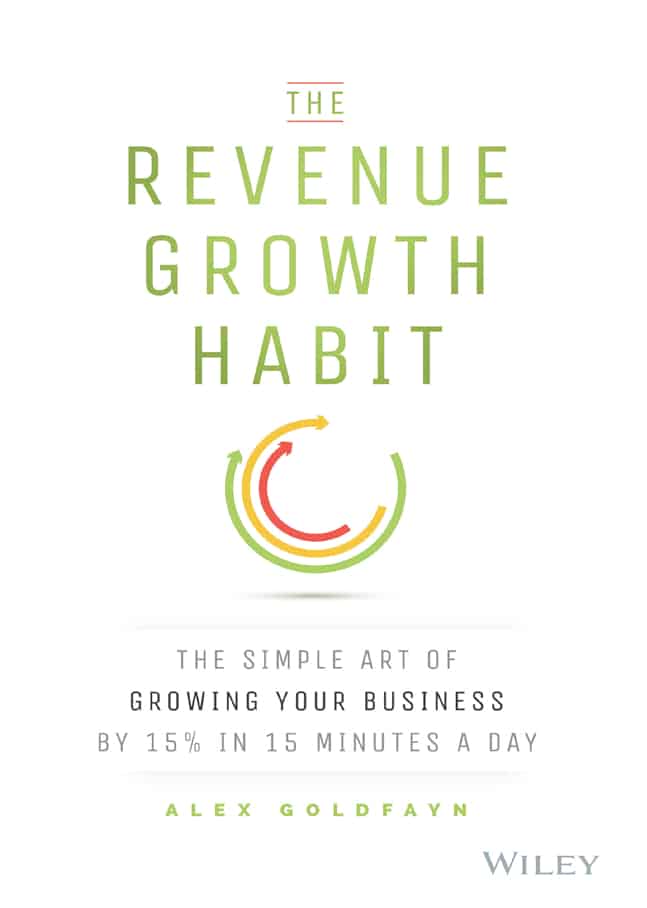I recently read The Revenue Growth Habit: The Simple Art of Growing Your Business by 15% in 15 Minutes a Day.

The book is broken down into four parts — the process, changing your mindset, 22 techniques for growth and executing the plan. I had planned to take all of the second quarter to read this book, but I enjoyed it so much that I read it in just a few weeks.
Revenue growth is proactive work. If you’re anything like me, or the people the author, Alex Goldfayn, describes, you spend a lot of time on reactive work — fighting fires, responding to clients, managing your business. Any time you have left is dedicated to proactive work — but honestly, is there a lot of time after that?
The author understands this, so he’s here to pitch that the proactive work can, and should, be simple and easy. It should only take 15 minutes a day and you can pick from any one of 22 different techniques. All the techniques are communication actions — you, communicating something of value to people who can buy from you. Many times it won’t even be your own words — rather the (wonderful) words of your (happy) customers. Quantity trumps quality (communicate frequently) and don’t wait until it’s perfect.
BUT before he gets too far in, he really wants to make sure you’ve bought in.
It’s all about the mindset
“It’s impossible to outmarket your mindset.” If YOU don’t believe in you, no one else will either. “How you think is how you market. If you believe you’re helping people and growing companies, you’ll market that.”
How many times have we thought things like:
- They’ll think I’m pushy
- They can’t afford it
- Why would they buy from me?
All of that is dangerous to you AND to your revenue growth.
Other great points from the chapters on mindset:
- To be successful, you need to focus less on the specific products and services you deliver and more on the value of what you offer — how you improve lives and companies.
- We all overcomplicate marketing — making it about branding and social media and advertising and search engines. But the author has a very simple definition of marketing for small to mid-sized businesses: systematically communicating your value to people who can buy it.
- Likewise, Facebook friends, Twitter followers, search engine positioning and hits/clicks/page views don’t matter as much as new revenue. To evaluate marketing efforts, ask yourself — is your company growing? Are you generating new revenue?
- Are you working to perfect your products and services, but not the marketing? Is everything else (selling, making customers happy, delivering on time, etc.) a priority, but not marketing?
- Are you uncomfortable talking about what you’re good at? In marketing, there’s no place for modesty. If you implement the author’s techniques, you won’t be telling people why you’re good — your customers will be. Also, it’s not bragging, it’s helping.
If you’re not sold yet, the author finishes out the section on mindset with chapters on frequently raised resistance and a quick activity showing you how your customers speak more positively about you than you speak about yourself. Both were excellent.
The techniques
There are 22 techniques in the book. I’ll give a brief list, but know that there are more and the author goes into detail about each one, so be sure to check out the book if I haven’t convinced you to already.
- Get those testimonials. He gives a framework on how to do this — on the phone, record the call, ask specific questions and follow up. One conversation with a customer can yield MANY quotes that you can use. And speaking of…
- Communicate the testimonials. How many times have you gotten a testimonial and then NOT USED IT? Not only should you use the testimonials but you should use them everywhere. All the places. Internally, externally. His rule of thumb is that everything that leaves your office should contain a testimonial.
- Create short, powerful case studies. There are four parts to a good case study: the problem, the solution, the value and a testimonial. I think a lot of people create a portfolio but neglect how the product or service created value for the client.
- Communicate the case studies to people who can buy from you. Just like gathering testimonials, there’s no use in doing so if you aren’t going to USE them. You’ve written great case studies, now put them to good use. The author gives a ton of ways to get those babies in front of the eyes of people who can buy from you.
- Make sure your existing customers know everything they can buy from you. They already like you, but ask them “did you know” questions to make sure they know that you offer other products or services.
- Ask for referrals, but don’t call them referrals because no one likes that word. He really wants you to ask over the phone, which may be uncomfortable, but since when is growth comfortable?
- Follow up with those quotes. You spent so much time talking to a potential client, gathering information and preparing a quote. Why are you not following up? The author gives a three-step process for following up over a period of three weeks with three emails.
- Write and send a handwritten note. No one else does it, so you’ll stand out.
- Grow your list, grow your list, grow your list. The author isn’t a fan of social media, rather of what he calls “your own social media” — your email list. I got the feeling that he was a little free with adding people to his list (he only very briefly touches on spam laws), but regardless, build your list. And as you do, segment.
- Then (you guessed it) email the list. Create a “wildly valuable” yet “very short” and “pretty frequent” newsletter. It should have three parts — an article of value, a testimonial and a promotion. It should take no more than 15 minutes to write and you should send one every two weeks.
- Speak at trade shows and conduct webinars. Self-explanatory.
- Use short, informal, helpful videos, put them on YouTube and share them with others. I know a lot of people who do this and I think it’s awesome.
- Increase your prices. Most people will stay with you.
- Edit your website text to talk about your customers. Start talking more about customers, pain points, success stories and value obtained and less about YOU.
Execute the plan
A book like this will not grow your revenue ONE BIT unless you take action. Don’t procrastinate and don’t overthink. He includes a planner in the book, but I couldn’t find a downloadable PDF, just an image from the book itself. There are also workbook questions in the back of the book to get you started.
Overall I enjoyed this book and plan to implement some of the techniques in my business going forward. If you’re a fan of business books and haven’t already, check out my review of Traction: Get a Grip on Your Business.
